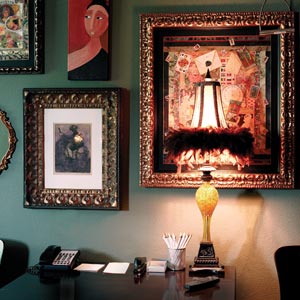|
"A picture is worth…" Fine arts insurance specialist describes the intricacies and opportunities of the collectibles market By Phil Zinkewicz
Television and movies have a tendency to romanticize particular professions. For instance, James Garner’s life as a private detective in the “Rockford” series is much more glamorous, exciting and dangerous than are the lives of real life private detectives; Peter Falk’s “Colombo” is a great deal more inscrutable than most police officers; and George Peppard as “Banacek,” the retriever of stolen art works, is compensated a good deal more lucratively than his true-life counterparts. Some years ago, a television series that originally emanated from Great Britain gave us the character of Lovejoy, played by British actor Ian McShane. Promoters of the “Lovejoy” series describe him as “charming, handsome and brilliant,” and not to be trusted for a second. He is an antique dealer who is passionate about fine art, constantly on the brink of bankruptcy, but with an ability to spot a genuine antique at a glance. He also has the remarkable knack of getting into trouble as he walks a fine line between legitimate fine arts business transactions and out-and-out disreputable business behavior. Viscount Charles Dupplin, head of the Fine Art and Private Client division of Hiscox plc, the largest insurer of fine art in Europe, is not Garner, Falk, Peppard or Ian McShane. But he does possess a quality that all four of those actors inject into their characters—a passion for his work. Recently, Viscount Dupplin attended a sort of “summit” in Miami, which included the most prestigious fine arts dealers in the world and corporate investors, the purpose of which was to unite these two segments in the recognition that fine arts represents an alternative asset class. Viscount Dupplin used the opportunity to discuss Hiscox’s own renowned fine arts corporate collection, which has been exhibited in a number of countries in Europe to critical acclaim. He also shared Hiscox’s experience as a corporate collector and Europe’s leading insurer of fine art. What’s more, Viscount Dupplin announced Hiscox’s intention of moving into the U.S. insurance market by opening an office here, the second Lloyd’s syndicate to do so within one year’s time. Moreover, he said that his distribution system will be U.S. agents and brokers. (See article here.) “When we discuss fine art, we’re talking about collectibles, collectibles of any kind that people are passionate about,” says Viscount Dupplin. “If we only insured paintings and sculptures, it would be pretty boring. There are people who collect stamps, coins, military uniforms and we even insure a collection of ancient Egyptian erotic art. We jokingly define art as something a client is more passionate about than his or her own spouse. There are public collectors, such as museums, private collectors who retain the art works for their own personal enjoyment, and commercial collectors who make their livings buying and selling. Then there are the art dealers who sometimes act in a broker capacity in an art sale but who also sometimes take a principal interest in the art work.” In his capacity as a fine arts insurance expert, Viscount Dupplin attends art exhibitions all over the world, although he says that, sadly, the number of exhibitions has dwindled since September 11 for fear of terrorism. “Because Hiscox has its own renowned corporate fine arts collection, started by our chairman, Robert Hiscox, we understand only too well the insurance needs of collectors, not only when the pieces remain in one place, but also when they are transported to exhibitions or lent out for periods of time to museums,” says the viscount. “We understand the exposures to loss because we’ve experienced some ourselves. We’ve had pieces of art stolen, some blown up by the IRA and some office cleaners took a cleanser to one of our paintings. “From the restoration of fragile pieces to the recovery of stolen works,” continued the viscount, “our expertise is extensive. Our relationships with the art world mean if you have to make a claim, you can be sure your case will be handled in the most sensitive way possible. Our clients include museums and galleries as well as individual dealers, exhibitors and collectors. We also offer insurance cover specifically geared towards professionals in the world of fine art such as auctioneers and valuers. We also offer defective title insurance, aimed at collectors and museums if there is an ownership dispute a client was unaware of at the time of purchase. This covers legal costs or expenses incurred in defending such claims, along with the agreed value of the item itself if required. The advantage we have over other insurers that sell fine arts insurance is that we know the business so well. For example, if a painting needs to be restored, we don’t just go with any restorer just to save money on the claim. We will choose a very specific restorer, who in an expert on that particular painter.” Citing one particular case, Viscount Dupplin discussed an artist named Yves Klein, who specialized in painting blue oblongs. “He used a very particular blue paint, which he had patented. One of his paintings began to fade, and we had to bring in a restorer who was an expert on Klein.” Viscount Dupplin says that valuing a piece of art is very difficult and very often quite subjective. “We employ independent, third-party valuers because we don’t want the client to think we’re pumping up the value to obtain a higher premium,” he says. “In some cases, if we feel the client is overvaluing a particular piece, we will inform him or her of our opinion, even though it means a lower premium. One recent case that comes to mind involved a man who had a collection of Toulouse-Lautrec paintings. The client suggested a value, but we thought it was on the high side. We wanted to find an expert on Toulouse-Lautrec, so we went to Christie’s and they gave us the name of a man they said was the finest expert in the world on the painter. It turned out the name they gave us was the client who came to us for insurance in the first place. Naturally, we then accepted his suggested value.” The viscount is extremely excited that this year Hiscox will be opening offices in the United States and that among the products it will offer is fine arts insurance. “Currently, the United States represents the largest art market in the world and we want to bring our European expertise over here. This is an area that will open up opportunities for brokers and agents if they have wealthy clients who collect.” Asked whether the agent or broker needs to have a background in fine arts, the viscount said no. “All the agent or broker has to do is ‘know the client’ and we’ll take it from there. We want to attract clients who are just starting out in collecting fine arts, so that we can help him or her grow in the art field.” And, Viscount Dupplin says that particular philosophy of “knowing the client” is one that Hiscox embraces. “We say there are three questions that need to be answered when providing insurance coverages. Those questions are: 1) Who is the insured? 2) Who is the insured? and 3) Who is the insured? If the agent or broker knows who he or she is dealing with, we will provide the expertise.” * |
|||
|




